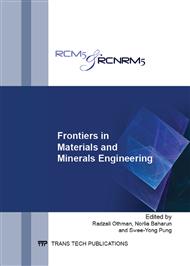p.13
p.19
p.24
p.32
p.40
p.46
p.52
p.56
p.60
Decolourization of Simulated Dye Wastewater Containing Reactive Blue 19 (RB19) by the Electro-Fenton Reaction in the Presence of Metal Oxide-Coated Electrodes
Abstract:
Reactive Blue (RB 19), also known as Remazol brilliant blue, is a widely-used colorant in various textile applications. RB 19 is very resistant to chemical oxidation due to its aromatic anthraquinone structure highly stabilized by resonance. Its relatively low fixation efficiency (75-80%) attributed to the competition between the formation of the reactive form (vinyl sulfone) and the hydrolysis reaction, results in its prevalence in textile wastewater discharges. In this study, electro-Fenton (EF) process, a popular advanced oxidation process (AOP) was used to treat RB 19 dye-containing simulated wastewater. The electrochemical reactor (0.5 L) used in all experiments had parallel plate/mesh electrodes coated with metal oxides. Synthetic textile wastewater was prepared by dissolving RB 19 dye (300 ppm) in distilled water. The effects of pH, initial [Fe2+], initial [H2O2] and current on RB 19 decolorization efficiency were investigated. Removal of 100 percent RB 19 was achieved at pH 2, 0.71 mM initial [Fe2+], 5 mM initial [H2O2] and 1.86 A in 20 minutes. High decolorization efficiencies and absence of sludge during the treatment process render the electro-Fenton process a viable treatment option for dye wastewaters.
Info:
Periodical:
Pages:
40-45
Citation:
Online since:
November 2013
Price:
Сopyright:
© 2014 Trans Tech Publications Ltd. All Rights Reserved
Share:
Citation:


